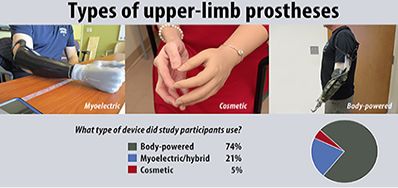Understanding Prosthesis Satisfaction
Share
Through the Eyes of Army Veteran Robert Lewis
In the journey of an amputee, finding the right prosthetic device is crucial. At Marins Med, we recognize the importance of a well-fitted body-powered device, especially in the initial stages of rehabilitation. A recent study published in Prosthetics and Orthotics International delved into user satisfaction among Veterans with upper-limb prostheses, revealing intriguing insights that resonate with our philosophy.
Study Insights: Satisfaction Levels Across Device Types
Dr. Linda Resnik of the Providence VA Medical Center led a comprehensive survey involving over 400 Veterans to understand their satisfaction with different types of upper-limb prostheses—myoelectric, body-powered, and cosmetic. Surprisingly, the study found little difference in satisfaction among users of these devices. This finding emphasizes that the type of prosthesis isn't the sole determinant of satisfaction; other factors like initial training and rehabilitation play a significant role.
The Role of Initial Training and Rehabilitation
The study highlighted that initial prosthetic training is crucial for long-term satisfaction. Veterans who received thorough training were more likely to integrate their devices into daily life, reducing frustration and increasing overall contentment. This aligns with our approach at Marins Med, where we stress the importance of early fitting and training.
Robert Lewis: A Personal Perspective
Army Veteran Robert Lewis's experience provides a personal perspective on the findings of the study. After losing his left arm below the elbow in a car accident, Lewis has utilized both myoelectric and body-powered prostheses to navigate his daily activities. His story underscores the importance of having reliable and versatile prosthetic options.
Lewis uses his myoelectric arm for light activities such as dressing and holding objects, while his body-powered prosthesis is reserved for more strenuous tasks like hunting and fishing. This dual-use approach is a testament to the adaptability and resilience of amputees when provided with the right tools. On a scale of 1 to 10, he rates both devices a five, indicating room for improvement but also appreciation for the benefits they offer.

The Value of Body-Powered Prostheses
Insurance providers, as Marins Med understands, typically require amputees to be fitted with a body-powered device first. This practice not only promotes healing but also ensures that the user has a reliable backup. Body-powered devices are known for their durability and simplicity, making them indispensable, especially in the early stages of rehabilitation.
Lewis’s body-powered prosthesis, which he uses for demanding activities, highlights the robustness and reliability of these devices. Despite some discomfort associated with extended use, he appreciates the device's utility and ease of maintenance.
Challenges and Aspirations
Both myoelectric and body-powered devices come with their challenges. Lewis mentions discomfort from extended wear and the need for better battery life and durability in myoelectric devices. These insights from real-life users are invaluable for advancing prosthetic technology.
At Marins Med, we are committed to addressing these challenges by continuously innovating and improving our prosthetic solutions. The study’s findings and Lewis’s experiences inspire us to push the boundaries of what’s possible, aiming for devices that offer not only functionality but also comfort and durability.
Improving Prosthetic Acceptance
In an industry marked by a high abandonment rate of prosthetic devices, improving prosthetic acceptance is crucial. Many amputees discontinue using their prostheses due to discomfort, lack of functionality, or poor fit. At Marins Med, we focus on creating prosthetic devices that address these issues head-on, ensuring that users receive a product that enhances their quality of life and encourages consistent use.
Looking Ahead
The study led by Dr. Resnik is a crucial step in understanding the diverse needs and experiences of upper-limb amputees. It reminds us that satisfaction with prosthetic devices is multifaceted, influenced by factors beyond the device itself. At Marins Med, we are dedicated to providing solutions that cater to these varied needs, ensuring that every user can lead a fulfilling and active life.
Robert Lewis's journey is a powerful reminder of the resilience and adaptability of amputees. His story, coupled with the insights from the study, reinforces our commitment to delivering prosthetic devices that enhance the quality of life for all our users.
The ProHensor (ProHook): Empowering Users
At Marins Med, our production positioning statement embodies our mission: "The ProHensor (ProHook) serves to improve prosthetic acceptance by enhancing functionality and ensuring durability. Designed with a user-centric focus, this body-powered device can be quickly adopted, fits within medical insurance parameters, and remains affordable. The ProHook empowers users to play hard, work hard, and push boundaries."
For more information on our innovative prosthetic solutions and how we can help you or a loved one, please visit our website or contact us directly.
About Marins Med
Marins Med is at the forefront of creating user-centric solutions for upper-limb amputees. With a focus on functionality, durability, and user satisfaction, we aim to transform lives through advanced prosthetic technology. Our commitment to innovation ensures that we continue to meet the evolving needs of our users.
